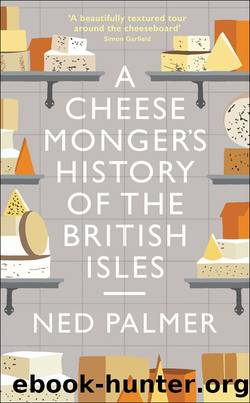A Cheesemonger’s History of the British Isles by Ned Palmer

Author:Ned Palmer [Palmer, Ned]
Language: eng
Format: epub
Publisher: Profile Books
Published: 2019-06-14T16:00:00+00:00
CHAPTER SIX
Stichelton
The birth of a brand
1688–1837
STILTON IS A QUINTESSENTIALLY BRITISH CHEESE – and perhaps just as quintessentially a product of the eighteenth century. If you think of that period as a time of ruddy-faced country squires quaffing foaming tankards of ale and bumpers of brandy, then a rich, piquant and indulgent cheese like this fits right in. Of course, there’s more to Stilton, and indeed the eighteenth century, than that. While the country squires no doubt did plenty of quaffing, and Stilton-eating while they were at it, this was a time of great and rapid change in Britain. It was a period of unification, agricultural revolution, improvement in transport, growth in commerce, leaps forward in science and technology, and a vastly increased presence for the country on the international stage. In 1755, the author of the annual directory The Present State of Great Britain felt able to boast that ‘Our trade is the most considerable in the whole world.’ And in 1787 The Gentleman’s Magazine reported: ’Of all the cheese this kingdom produces, none is more highly esteemed than the Stilton.’
So what is it that makes a Stilton so great – and, indeed, what makes a great Stilton? First, there are the things all mongers can agree on. Stilton is made from cow’s milk and comes in a cylinder about a foot tall and ten inches across. A good Stilton has a knobbly rind in a light tan shading to orange. Sometimes there are shades of blushing pink on this rind, a phenomenon that some cheesemongers like to call ‘baboon’s bum’. (If you see baboon’s bum on a Stilton, buy some straight away – I guarantee that cheese will be a stunner.) To the touch, the rind of a Stilton should be lightly moist and, when finally you cut the cheese open, its paste should be the colour of old ivory piano keys, with blue veins radiating out in a marbled pattern. The shade of blue is important. Indigo is perfect. If the blue is too light, it will lack intensity. If it is very dark, it will taste sharp, overly spicy and perhaps even a tad metallic. And when you at last put some Stilton in your mouth, it should have a meltingly creamy texture, a bit like a soft fondant icing.
My favourite Stilton, which ticks all the boxes I have drawn above – and has a flavour that has hints of malty digestive biscuit, Marmite and bubblegum – is made by Colston Bassett Dairy in Nottinghamshire, by a brilliant cheesemaker called Billy Kevan and his team. They collect their milk from nearby farms in the area, giving it the terroir of the Vale of Belvoir, a place long famous for cheese. The dairy was established in 1912 and Kevan is only the fourth cheesemaker in a century. There’s continuity for you.
There’s an origin myth for blue cheese. I’ve been told variations of it by cheesemakers, mongers and affineurs from France, Spain, Italy, England and Wales and, as with all origin myths, each teller has patriotically located the story in their own country.
Download
This site does not store any files on its server. We only index and link to content provided by other sites. Please contact the content providers to delete copyright contents if any and email us, we'll remove relevant links or contents immediately.
Kathy Andrews Collection by Kathy Andrews(11765)
The remains of the day by Kazuo Ishiguro(8890)
Spare by Prince Harry The Duke of Sussex(5140)
Paper Towns by Green John(5136)
The Body: A Guide for Occupants by Bill Bryson(5027)
Industrial Automation from Scratch: A hands-on guide to using sensors, actuators, PLCs, HMIs, and SCADA to automate industrial processes by Olushola Akande(5024)
Machine Learning at Scale with H2O by Gregory Keys | David Whiting(4258)
Be in a Treehouse by Pete Nelson(3996)
Never by Ken Follett(3882)
Harry Potter and the Goblet Of Fire by J.K. Rowling(3808)
Goodbye Paradise(3761)
Into Thin Air by Jon Krakauer(3347)
The Remains of the Day by Kazuo Ishiguro(3346)
Fairy Tale by Stephen King(3307)
The Cellar by Natasha Preston(3297)
The Genius of Japanese Carpentry by Azby Brown(3254)
120 Days of Sodom by Marquis de Sade(3226)
The Man Who Died Twice by Richard Osman(3040)
Drawing Shortcuts: Developing Quick Drawing Skills Using Today's Technology by Leggitt Jim(3037)
